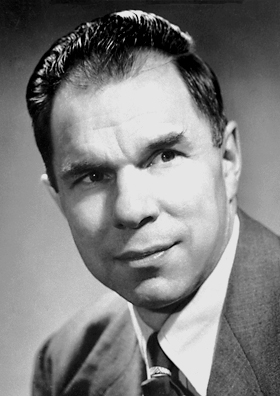"The Transuranium Elements : Present Status" Nobel Lecture (12 December 1951) http://www.nobelprize.org/nobel_prizes/chemistry/laureates/1951/seaborg-lecture.html
Kontekst: I suppose that I should say a few words with respect to the possibility for future production and identification of additional transuranium elements, especially in view of the possibility of their production by heavy-ion bombardment of transuranium elements. As an aid to such a program the radioactive properties can be estimated, as I have already indicated, on the assumption of a smooth nuclear energy surface and the systematics of radioactivity. Again, I must emphasize that such considerations are negated in the event that a stable subshell of 148 neutrons should be found to exist, and this must be regarded as a definite possibility. It is interesting to note that our considerations on the systematics of spontaneous fission28 indicate that this method of decay will not compete seriously with radioactive decay until the region just beyond element 100. … These considerations illustrate clearly that one of the problems is that of conceiving means for producing nuclides of sufficiently high mass numbers with half-lives long enough for chemical identification. Thus, the serious problem is again the paucity of starting materials.
Glenn Theodore Seaborg: Cytaty po angielsku
Statement upon being appointed as UC Berkeley chancellor in 1958, as quoted Biographical Memoirs (2000) edited by Darleane C. Hoffman, p, 252 <!-- ISBN 0-309-07035-X National Academies Press-->
Kontekst: There is a beauty in discovery. There is mathematics in music, a kinship of science and poetry in the description of nature, and exquisite form in a molecule. Attempts to place different disciplines in different camps are revealed as artificial in the face of the unity of knowledge. All literate men are sustained by the philosopher, the historian, the political analyst, the economist, the scientist, the poet, the artisan and the musician.
“There is a beauty in discovery.”
Statement upon being appointed as UC Berkeley chancellor in 1958, as quoted Biographical Memoirs (2000) edited by Darleane C. Hoffman, p, 252 <!-- ISBN 0-309-07035-X National Academies Press-->
Kontekst: There is a beauty in discovery. There is mathematics in music, a kinship of science and poetry in the description of nature, and exquisite form in a molecule. Attempts to place different disciplines in different camps are revealed as artificial in the face of the unity of knowledge. All literate men are sustained by the philosopher, the historian, the political analyst, the economist, the scientist, the poet, the artisan and the musician.
"The Transuranium Elements : Present Status" Nobel Lecture (12 December 1951) http://www.nobelprize.org/nobel_prizes/chemistry/laureates/1951/seaborg-lecture.html
Kontekst: I suppose that I should say a few words with respect to the possibility for future production and identification of additional transuranium elements, especially in view of the possibility of their production by heavy-ion bombardment of transuranium elements. As an aid to such a program the radioactive properties can be estimated, as I have already indicated, on the assumption of a smooth nuclear energy surface and the systematics of radioactivity. Again, I must emphasize that such considerations are negated in the event that a stable subshell of 148 neutrons should be found to exist, and this must be regarded as a definite possibility. It is interesting to note that our considerations on the systematics of spontaneous fission28 indicate that this method of decay will not compete seriously with radioactive decay until the region just beyond element 100. … These considerations illustrate clearly that one of the problems is that of conceiving means for producing nuclides of sufficiently high mass numbers with half-lives long enough for chemical identification. Thus, the serious problem is again the paucity of starting materials.
